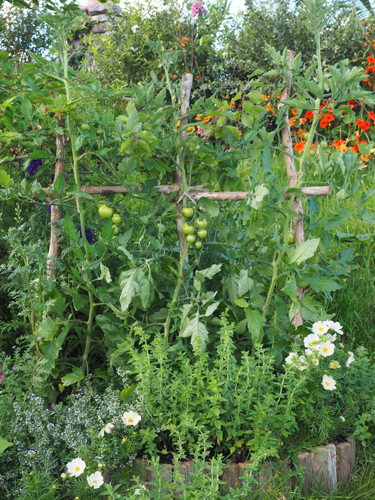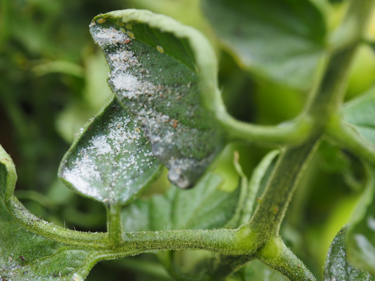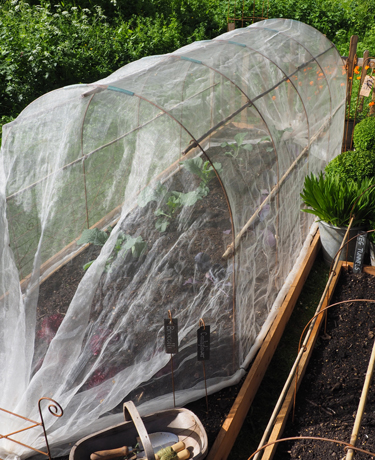Care for tomatoes
Tomatoes are tigers for punishment, attracting more than their fair share of summer pests and diseases. Especially now that the terrible Tomato and Potato Pysllid has made its presence felt, it can be tempting to throw one’s hands up in defeat.
But the fact remains, there is no denying the superior taste of a home grown tomato and bugs can be beaten. The trick as always is to know your enemies intimately and then take the common sense approach known as ‘Integrated Pest Management’.
Start with healthy plants
Some tomato varieties are more disease resistant than others. Depending on where you live and which pests or diseases are more problematic, there will be varieties that fare better in your garden than others. Working out which are best for you is largely a matter of trial and error plus sharing success stories among friends and neighbours. Ideally, select a diverse selection of varieties known for their disease resistance. Grafted tomato plants offer disease resistant roots and extra vigour. Early ripening varieties can provide a crop before the worst pests and diseases take hold.
Support vigorous growth
Regardless of variety, a healthy, well fed and well watered plant has a better chance of fighting off attacks from pests and pathogens than a sickly malnourished one. Healthy plants need healthy soil. Deep, dark and spongy soil, rich in organic matter ensures water and nutrients are easily accessible to plants and, whatever your preferred way of feeding them, tomatoes need a continuous supply of nutrients to support their rapid growth.
Infrequent soaking encourages young roots to grow deeply into the soil where there is a good supply of moisture and nutrients. Frequent shallow watering encourages shallow root growth more likely to suffer in a dry spell. Apply water directly to the soil. Sprinklers are best avoided as wet leaf surfaces invite disease. Mulching with a layer of straw or fine bark will help keep the moisture in the soil where it is needed.
Tip: Plant seedling tomatoes a few centimetres deeper than they were in their pots to stimulate new feeder roots for extra anchorage and nutrient uptake.
Fresh air
Tomato bugs thrive and multiply in damp warm humidity. Keeping the above ground parts of the plant dry and well aerated is key. Keep them weed-free with plenty of space for air. Too much air movement, on the other hand isn’t helpful as wind damage is a potential entry point for disease.
Crop rotation
Avoid planting tomatoes and their relatives (potatoes, capsicum, chillies, eggplants) in the same place year after year. The longer a garden bed has a rest from any one plant family, the better. If it’s too hard to change the planting place, consider changing the soil or planting tomatoes in containers.
Basic hygiene
Be aware that disease spores can be transferred from one plant to another via tools or fingers. Also, avoid pruning tomatoes on a wet or humid day as moisture assists disease entry. Also, seed saved from an infected crop may carry over disease to the next crop. Be sure of your source or obtain fresh seed or seedlings from a reputable supplier.
When lower leaves show signs of disease remove them, ideally with clean sharp tools. Sometimes it may be necessary to remove an entire plant. Refrain from adding infected material to your home compost heap, which is unlikely to get hot enough to kill all the disease spores and insect eggs.
Take good care of nature
Every pest has its natural predators. Think carefully before spraying pesticides and try planting a variety of herbs and flowers to attract a range of predatory insects.
Know your enemy
Whatever your crop, awareness and early intervention are an essential first line of defence in the battle of the bugs. Observation can be a lethal weapon so keep a close look out for the first signs of a problem especially as the weather warms up in summer. It’s easier to come up with creative solutions when you know how your pests favourite environmental conditions and how it lives and breeds.
Preventive measures
Spraying with protective fungicides such as copper provides effective control against fungus diseases when applied early in the season before the disease cycle takes hold and when wet weather or high humidity makes infection likely. Copper is an accepted as organic spray option, but its overuse is a concern for soil health.
Targeted remedies
When all else fails, spraying with the right product at the right time can be the most cost effective option to save a crop under threat. Garden centres are a good place to go for help in choosing the right product. Today’s registered home garden pesticides are at the very low end of toxicity and pose no risk to humans when used as directed. Several are also safe to bees once they have dried on the plant. Neem tree oil is a natural product that controls a wide range of insects. It can be applied as a spray or as granules in the soil. All pesticides, including natural sprays have the potential to harm beneficial insects and soil microorganisms.
Bug net
Mesh crop cover fabric is now available in garden centres and is an effective way to prevent insect pests including psyllids from laying their eggs on crops.
Tomato troubles
Diseases
Early blight is a fungal disease which starts by causing distortion of the new growth, followed by brown or black spots. Eventually the whole plant may die. Early blight is more likely to attack plants under stress and is encouraged by damp conditions. Spraying early with a protective fungicide provides effective control. Late blight is caused by a microorganism called Phytophthora which thrives in a warm moist environment. Brown patches appear on the leaves and can spread very fast. Avoid wet foliage. This disease is practically impossible to control once it sets in but early sprays with a protective fungicide will help suppress it. When tomato leaves turn yellow and wilt the plant may be under attack from Verticillian Wilt, a soil fungus which invades the roots or the base of the stem, usually in cool wet conditions. Remove the entire plant before the disease spreads.
Disorders
Despite appearances, some tomato problems are not caused by anything living. Blossom End Rot is the plants response to lack of calcium uptake, usually as a result of an inconsistent water supply. Dark brown hollow patches form at the base of the fruit. Greenback happens when the fruit refuses to ripen at its stalk end, which may be caused by erratic watering or excess heat. Fruit Split is common when plants receive an overload of water after a dry spell, or with fluctuating temperatures.
Hungry Caterpillars
Tomato fruit worm is actually a caterpillar which eats holes into fruit, leaving black excreta in its wake. The adult moths feed on nectar and lay eggs by night, hiding away during the day. This pest feeds on a wide range of plants and is very partial to corn. Avoid planting tomatoes next to sweetcorn. Treat infestations with Yates Success.
Sucking insects
Aphids and whitefly suck the sap from your plants and breed like fury in warm spring conditions. If a cloud of white bugs rises from your plants you have a whitefly infestation. Complete control of this pest calls for repeated spray applications every few days for about two weeks because only the young nymph stage of its lifecycle is susceptible. By far the most destructive and difficult to control tomato pest is the Tomato and Potato Psyllid (TPP). The adults look like tiny cicadas, about 3mm long. Yellowish nymphs appear on the underside of the leaves. Their excreta looks like grains of sugar. The worst thing about this sap-sucker is that it injects bacteria which severely weaken the plant with significant loss in yield. TPP is hosted by many plants in the tomato family, including weeds. Protective measures include covering plants with fine insect mesh and removing host plants where TPP may camp over winter. Yates Maverick is registered to control all three of these sucking insect pests. Complete coverage and early detection are key.

6-Dec-2018

Tomatoes planted with herbs and flowers in a raised bed

Bush tomoato in a black pot

Psyllid 'sugar'

Bug netting will protect plants from pests.

